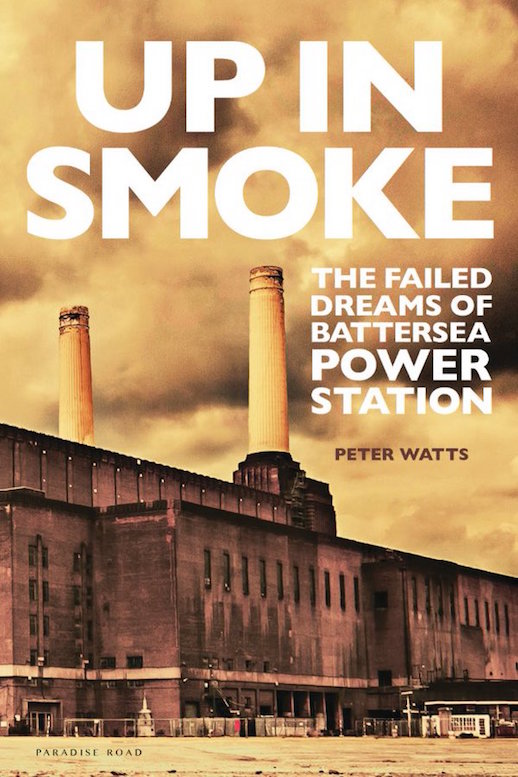Post
BOOK REVIEW: Up in Smoke by Peter Watts
29 Jun 2016
Up in Smoke: The Failed Dreams of Battersea Power Station by Peter Watts
Paradise Road, 2016, £20.
Review by Terence Bendixson
Opponents of the power station did not mince their words. Pollutants from it would 'kill every green thing within two miles of Battersea, rot all buildings and bleach all the babies'. Thus wrote Edward Young, MP, to the Private Secretary of the Prime Minister in 1929. Even chain- smoking King George V, recovering from lung surgery at Bognor, joined in. 'His Majesty feels the greatest concern at the prospect of the atmosphere of London being still further polluted…' his secretary wrote to Neville Chamberlain, then Minister of Health.
It is not controversy about air pollution that dogs (pun intended) Battersea's giant power station today, but what Will Self has called 'class cleansing' and domination by foreign - in this case Malaysian - capital. Could it have been otherwise? Might a sister organisation to the Coin Street Community Association have risen up to devote the power station to the dreams of Londoners? Might another Nicholas Serota, whose boldness and imagination have made Bankside the most popular museum of modern art in the world, have ridden in on a shining installation and rescued Battersea from commercial exploitation?
Peter Watts, for 25 years a London-based journalist, writes a deft and finely illustrated account of the ups and downs of what I refuse to call Giles Gilbert Scott's iconic building. He also makes clear that Battersea's size – about twice that of Bankside – and its much worse state of repair, made it inevitable that it would have to be rescued by private money. The huge renewal cost, plus a need to pay £1bn to extend the Northern Line, also explains what many see as the main failing of Rafael Viñoly's masterplan: the enshrouding of the power station, except as seen from the Thames, by walls of flats. Watts is good on architecture, good on politics and good on skulduggery.
And what a saga it is. Scott's early drawing show a power station with four square chimneys ('I confine my work entirely to matters of appearance,' he told the engineers). These bold towers, ruled out by insufficient foundations (already in place when Scott got to work), are a revelation and give the design a coherence its successor so sadly lacks.
In the 1980s and 1990s John Broom's failed attempt to turn the power house into a metropolitan Alton Towers, with riders screaming past Scott's walls, gave way to 'The Parkview Years' when the site was taken over by millionaire Victor Hwang from Hong Kong. These were times of wild ideas (including a rising restaurant with a single circular table in one of the flues) and architects' visions. In one John Outram turned the hulk into a 700-room hotel with giant Egyptian columns. In another Neven Sidor of Grimshaws envisaged a futurist interior with an infinity of escalators rising under the south chimneys. Meanwhile, as London succumbed to Millennium fever and globalisation caused property values to soar, Hwang's dream of 'the power station as the centrepiece of a genuine public space, with parks, theatres, conference centres…..' gave way to the plans of new Irish owners who 'had one objective in mind: making money, and lots of it'. The new cast, led by pony-tailed Johnny Ronan, a man associated in the Irish press with fast cars, fast money and faster women, considered demolition, collided with the Battersea Power Station Community Group, brought in Rafael Viñoly as master-planner and, after one or two false starts, arrived at what is now under construction. Ronan then went bust in the Irish property crash, Terry Farrell proposed to treat Scott's structure as a 'managed ruin' and Will Self went further. He proposed to make the carcase safe 'for people to walk around and admire…for the Ozymandian monument…it is'.
So the story ends with Malaysian money in charge, construction under way and, it is said, six out of ten buyers from London. It may not be a 'people's plan', whatever that might be, but the future Electric Boulevard, flanked by Norman Foster's undulating Roof Gardens and Frank Gehry's swinging titanium skirts, will certainly be a memorable place. Will Brexit stop it? Not if a decline in the pound creates property bargains. As for the place as a whole, my guess is that while aesthetes will damn it, Londoners will flock to it. Peter Watts has reservations but tells the story with verve.
